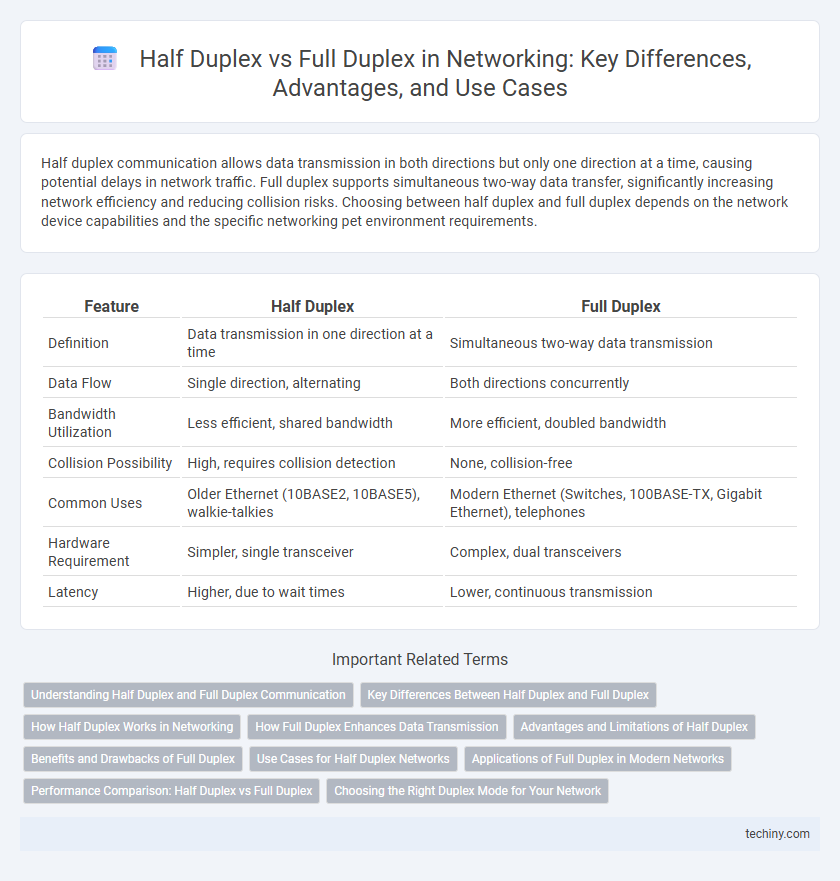Half duplex communication allows data transmission in both directions but only one direction at a time, causing potential delays in network traffic. Full duplex supports simultaneous two-way data transfer, significantly increasing network efficiency and reducing collision risks. Choosing between half duplex and full duplex depends on the network device capabilities and the specific networking pet environment requirements.
Table of Comparison
| Feature | Half Duplex | Full Duplex |
|---|---|---|
| Definition | Data transmission in one direction at a time | Simultaneous two-way data transmission |
| Data Flow | Single direction, alternating | Both directions concurrently |
| Bandwidth Utilization | Less efficient, shared bandwidth | More efficient, doubled bandwidth |
| Collision Possibility | High, requires collision detection | None, collision-free |
| Common Uses | Older Ethernet (10BASE2, 10BASE5), walkie-talkies | Modern Ethernet (Switches, 100BASE-TX, Gigabit Ethernet), telephones |
| Hardware Requirement | Simpler, single transceiver | Complex, dual transceivers |
| Latency | Higher, due to wait times | Lower, continuous transmission |
Understanding Half Duplex and Full Duplex Communication
Half duplex communication allows data transmission in both directions, but only one direction at a time, causing devices to alternate between sending and receiving modes. Full duplex communication enables simultaneous two-way data exchange, doubling the effective bandwidth and reducing collisions in networking environments. Understanding the differences is crucial for optimizing network performance, especially in Ethernet, Wi-Fi, and telephone systems.
Key Differences Between Half Duplex and Full Duplex
Half duplex communication allows data transmission in both directions but only one direction at a time, whereas full duplex enables simultaneous two-way data transfer. Half duplex systems often suffer from collisions and require mechanisms like Carrier Sense Multiple Access with Collision Detection (CSMA/CD), while full duplex systems eliminate collisions by using separate channels. Full duplex improves network efficiency and speeds up data flow by doubling the communication capacity compared to half duplex.
How Half Duplex Works in Networking
Half duplex networking allows data transmission in both directions but only one direction at a time, preventing simultaneous sending and receiving of signals. Devices using half duplex communicate by alternating between transmitting and receiving modes, often controlled by collision detection mechanisms like CSMA/CD in Ethernet. This method reduces network efficiency compared to full duplex but simplifies hardware design and is suitable for shared media environments.
How Full Duplex Enhances Data Transmission
Full duplex communication allows simultaneous data transmission and reception, effectively doubling the potential throughput compared to half duplex, which limits communication to one direction at a time. By enabling concurrent send and receive operations, full duplex reduces latency and minimizes collisions in network traffic, enhancing overall efficiency. This capability is crucial in high-speed networks like Gigabit Ethernet, where maximizing bandwidth utilization significantly improves performance.
Advantages and Limitations of Half Duplex
Half duplex communication allows data transmission in both directions but only one direction at a time, which reduces the likelihood of collisions on a shared medium, making it cost-effective for simple network setups. Its limitations include lower data throughput and increased latency compared to full duplex systems, as devices must wait their turn to transmit. This mode is often used in legacy Ethernet hubs and walkie-talkies, where simplicity and reduced hardware costs outweigh the need for simultaneous bidirectional communication.
Benefits and Drawbacks of Full Duplex
Full duplex networking allows simultaneous two-way communication, significantly increasing data transmission efficiency and reducing latency compared to half duplex. This mode eliminates collisions since devices can send and receive data at the same time, enhancing overall network performance, particularly in high-traffic environments. However, full duplex requires more complex hardware and network infrastructure, potentially increasing setup costs and compatibility challenges with legacy systems.
Use Cases for Half Duplex Networks
Half duplex networks are ideal for communication environments where simplicity and cost-effectiveness are priorities, such as walkie-talkies, CB radios, and early Ethernet hubs. These networks operate efficiently in scenarios with low to moderate traffic where devices take turns transmitting, minimizing collisions and network complexity. Industrial control systems and certain wireless networks also utilize half duplex communication to maintain reliable data exchange without the need for simultaneous two-way transmission.
Applications of Full Duplex in Modern Networks
Full duplex communication enables simultaneous two-way data transmission, significantly improving network efficiency in modern applications such as VoIP, video conferencing, and real-time data streaming. This technology eliminates collisions and reduces latency by allowing devices to send and receive data concurrently over Ethernet switches and fiber optic networks. Key use cases include enterprise LANs, data centers, and 5G cellular networks where high throughput and low delay are critical.
Performance Comparison: Half Duplex vs Full Duplex
Full duplex networking enables simultaneous two-way data transmission, doubling the effective bandwidth compared to half duplex where data flows in only one direction at a time. This simultaneous communication reduces collisions and network congestion, significantly improving overall throughput and latency. Half duplex systems, commonly found in older Ethernet and wireless setups, experience performance limitations in high-traffic environments due to waiting times for channel access, whereas full duplex is standard in modern switched networks for optimal performance.
Choosing the Right Duplex Mode for Your Network
Selecting the appropriate duplex mode depends on network requirements and device capabilities. Full duplex offers simultaneous two-way communication, reducing collisions and increasing throughput, ideal for modern high-speed networks. Half duplex, supporting one-way communication at a time, suits legacy systems or simple setups with limited bandwidth and lower traffic demands.
Half Duplex vs Full Duplex Infographic

 techiny.com
techiny.com